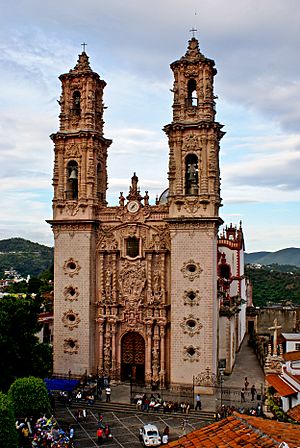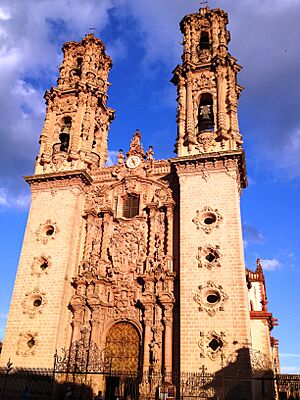Church of Santa Prisca de Taxco facts for kids
Quick facts for kids Church of Santa Prisca de Taxco |
|
|---|---|

The façade
|
|
| Location | Taxco |
| Country | Mexico |
| Denomination | Roman Catholic Church |
| Architecture | |
| Style | New Spanish Baroque |
| Groundbreaking | 1751 |
| Completed | 1759 |
| Specifications | |
| Height | 40.40m (132.54 ft) |
| Nave height | 18m (59 ft) |
| Other dimensions | 28.30m (height of facade to the top of the image of La Purisma) |
| Number of towers | 2 |
| Tower height | 40.40m (132.54 ft) |
| Materials | Stone |
The Church of Santa Prisca is a famous old church. It is in the city of Taxco de Alarcón in Mexico. This beautiful church was built a long time ago, between 1751 and 1759. You can find it on the east side of Taxco's main square.
A very rich mine owner named José de la Borda paid for the church. He was one of the wealthiest people in Taxco in the 1700s. For many years, from 1758 to 1806, it was the tallest building in Mexico. The Church of Santa Prisca is known for its amazing Churrigueresque style. This is a very fancy and detailed type of art and building design from New Spain.
Contents
Building the Church
The Church of Santa Prisca was built between 1751 and 1759. José de la Borda paid for it. He had made a huge fortune from the silver mines around Taxco. Even with all his money, building this grand church almost made him go broke!
The construction of the church took 15 years. José de la Borda wanted to create a special place. His son, Manuel de la Borda, was a priest. This church was built so his son could lead church services there.
José de la Borda had only lived in Taxco for about 35 years. But he was already very important in the mining area. Because of this, the Archbishop of Mexico allowed him to build the church exactly how he wanted.
Cayetano José de Siguenza drew the plans for the church. It was designed in the shape of a narrow Latin cross. This was because of the shape of the land. The architect Diego Durán Berruecos built it. The beautiful altarpieces inside were designed by the brothers Isidoro Vicente and Luis de Balbás.
What the Church Looks Like
The church is built in a slightly lower area of Taxco. It has a Latin cross shape. There is a side area that serves as a chapel. It also has a special area with unique ribbed ceilings. These ceilings hide the entrance to the sanctuary.
The church has two tall towers that look exactly alike. They are built in the fancy Churrigueresque style. There is also a chapel decorated with Talavera tiles. These colorful tiles are a special part of New Spanish architecture.
The front of the church faces west, which was common. It mixes classic columns with twisted columns from the 1600s. There are also many other decorations. These include scrolls, ribbons, leaves, and statues of saints. All these details make the church look very rich and full of art.
The tall towers are very detailed at the top. They frame the main entrance, which looks like a large altarpiece. The front of the church shows a special way of building that was popular at the time.
Inside, Santa Prisca has nine large altarpieces. They go from the floor all the way to the ceiling. These altarpieces are made of wood and covered with real gold leaf. Their style matches the rest of the church. They are a great example of New Spanish Baroque art from the mid-1700s.
The main altarpiece is dedicated to the Immaculate Conception. It also honors the patron saints of Taxco: Saint Prisca and Saint Sebastian. This altarpiece looks like many carvings stacked on top of each other. It seems like one big, flowing piece of art. In other parts of the church, there are two more important altarpieces. One is for the Virgin of Guadalupe, and the other is for the Virgin of the Rosary.
The main ideas shown in the church's art are: Saint Prisca, Saint Sebastian, and the evangelists. You can also see shells, which mean Jesus's baptism. Laurel leaves mean the triumph of faith. Grapes represent the blood of Christ.
Inside the church, there are paintings by Miguel Cabrera. He was a famous painter from the 1600s. José de la Borda asked him to paint the artworks for the church. Miguel Cabrera painted Martyrdom of St. Sebastian and Martyrdom of St. Prisca. He also painted a large Assumption that is still in the sacristy.
The oldest record from the church's history goes back to 1598.
The Legend of Santa Prisca
There is a special story about the Santa Prisca Church. One time, while the church was being built, José de la Borda left Taxco for business. He left the builders in charge. Soon after he left, dark clouds filled the sky. Cold winds blew through the unfinished towers. The workers were scared as a big storm came closer.
Suddenly, a huge bolt of lightning struck. It showed a dark shape flying down towards the church. Then, it hit the church's dome, making it glow brightly. All the tiles on the dome began to shine with strange lights. An inscription could be seen clearly: "Glory to God in the Highest and peace on earth for men with good will."
Everyone in the town got on their knees to pray. They were afraid that angry demons would destroy the church. Flashes of light floated around the church. Above the church, a beautiful woman appeared. She was smiling and looked peaceful. She caught the lightning bolts in her hands.
Images for kids
-
Main altar of the Church in 1908. INAH.
-
The Martyrdom of St. Prisca (1760) by Miguel Cabrera. Located inside.
Learn More
See also
 In Spanish: Templo de Santa Prisca (Taxco de Alarcón) para niños
In Spanish: Templo de Santa Prisca (Taxco de Alarcón) para niños


















